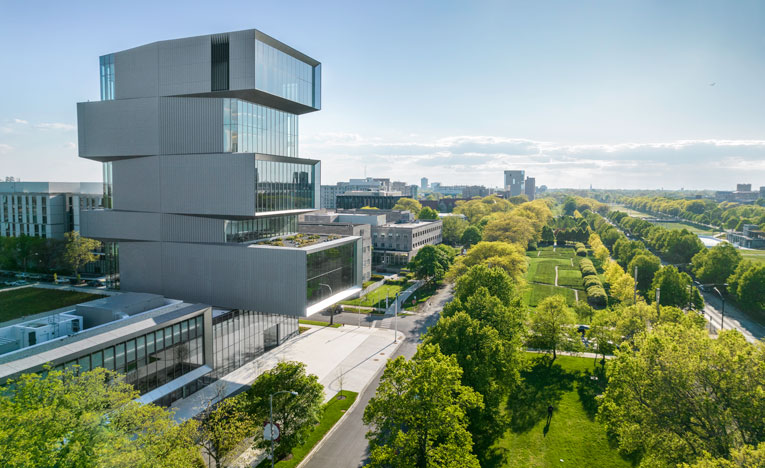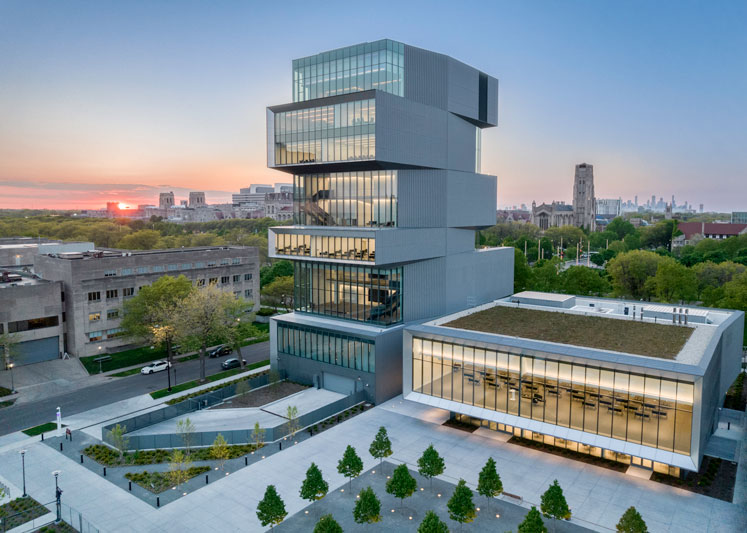The Council on Tall Buildings and Urban Habitat has named the David Rubenstein Forum at the University of Chicago as the Best Tall Building Worldwide in its annual award program.
“With the United Nations projecting nearly 70 percent urbanization by 2050, the demand is growing for healthier, more sustainable, and socially just urban environments—tall buildings and other smart, resilient approaches to population density are an integral part of the solution,” says CTBUH CEO Javier Quintana de Una. “The projects selected for our yearly Award of Excellence competition represent the most advanced concepts and technologies currently employed around the world, and the David Rubenstein Forum in particular exemplifies the diversity of interdisciplinary ingenuity required to address the complex needs of students, workers, communities and the public in general.”
The David Rubenstein Forum, designed by Diller Scofidio + Renfro (design architect and architect of record) and Brininstool + Lynch (associate architect), is composed of a two-story base and a slender, eight-story tower that serves a wide range of users. The tower is organized as stacked and rotated “neighborhoods,” oriented toward the university’s campus in Hyde Park and the city of Chicago to the north, as well as the nearby Woodlawn community and others further south.
A fulcrum point in the tower’s massing—the stitch line—balances the opposing north and south cantilevers to create a self-supporting structure much like a seesaw, allowing large cantilevers with a minimal amount of concrete. The 40-foot cantilever—one of the longest spanning concrete cantilevers in the city—at the north entrance of the building welcomes visitors and affords ample space to congregate before and after events. The building’s flexible spaces accommodate formal and informal gatherings, as well as much needed multipurpose meeting spaces.
“The David Rubenstein Forum is an intellectual destination for an engaged and diverse range of scholars, leaders and community members at and around the University of Chicago, who convene to discuss issues and solutions to great challenges facing the world. Its design fundamentally rethinks and improves the traditional conference center by creating contemplative and collision spaces that foster the creation and exchange of ideas,” explains University of Chicago President Paul Alivisatos. “Its design shifts to relate visually and tangibly to communities to the south and north of the city.”
The LEED-Gold certified building integrates bird-safe technology in its glass façade; utilizes green roof technology; and, every meeting room has floor to ceiling glass to provide large amounts of natural light, thereby cutting down on energy costs. Lastly, it uses energy-efficient conditioning systems that achieve indoor comfort levels primarily via passive radiant technology, significantly mitigating its carbon footprint.
“It is no longer enough to simply build tall,” adds Quintana de Una. “We must approach density in ways that are meaningful, creative, innovative, carbon neutral and affordable. Only then can we support balanced and healthy living, working and civic and social engagement. The David Rubenstein Forum, and all of this year’s Award of Excellence winners, demonstrate that it is possible to consider the built environment—transportation, public and cultural institutions, green spaces, commercial enterprises, and other crucial infrastructure—holistically and adapt it broadly and equitably for positive, sustainable outcomes.”

